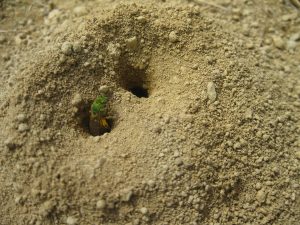Common wild bees found in blueberry fields
For three springs I’ve collected bees from blooming blueberry fields and, with the help of experts, given them a species name. I have not collected bumblebees since I did not want to take away bumblebee queens while they foraged in the fields! So my collection includes all bees except bumblebees and honeybees. In general, I’ve found three major groups of bees in the blueberry fields.
These are:
- genus Andrena
- the Halictinae group: genus Halictus, Lasioglossum, Agapostemon, Augochlorella, and Augochlora (I’ve only found a very few of these).
- the cleptoparastic groups: Nomada and Sphecodes.
The goal with this post is to relate some information about these genera so farmers and growers can know more about the bees found in their fields.
Andrena: All species of this genus nest in the ground. They dig tunnels and excavate small cells off the main passageway where they place a smooth ball of pollen and lay an egg. The pollen becomes the food for the larvae that hatch from the egg. The pollen comes from the flowers the female bee visits in the blueberry fields. Usually, the female has their own individual nests, but sometimes they are clustered in the blueberry fields in fairly dense aggregations. You most easily find the nests in the early spring when the blueberry leaves are not fully out. Just look for a black and yellow/white bee- smaller than a bumblebee, landing on or taking off from the ground. About 28% of the bees I’ve caught are Andrena and they have been in all fields. I’ve been able to look at the pollen the adult females are carrying when I catch them and have found the pollen loads to average about 78% blueberry pollen which means that most of these bees visit blueberry plants very frequently. I would categorize Andrena as important wild pollinators.
When the blueberry flowers start to fade I’ve found these bees foraging on raspberry, blackberry, rose, and sheep laurel (lamb kill).
There is more information about this genus in an entry posted October 25, 2012.

Halictinae bees: These can be bright green, so when you see metallic flashes as a bee flies by you are most likely seeing one of this group. Some are black with white bands on the abdomen. They often are small- just about 6-12 millimeters long. They mostly make nests in the ground. They either nest on their own, or communally, or even make different classes of workers like a honeybee or bumblebee. A little over 60% of the bees I’ve caught are from this group- the vast majority from the genus Lasioglossum. They are found in all fields. Some species from this group are probably important pollinators for blueberry (the few Halictus I’ve been able to examine have 100% blueberry pollen in their pollen loads). But, I’m unclear how much pollination can be attributed to Lasioglossum or Augochlorella.
Cleptoparasitic bees: I’ve commonly caught two genera that fall into this group: Nomada and Sphecodes. These bees don’t make their own nests and don’t gather their own pollen. Instead, they enter the nests of other bee species, destroy the egg that has been laid there and lay their own egg so their young can feed on the pollen. I’ve caught these bees while they visit blueberry flowers (most likely consuming nectar), but since they don’t gather pollen they can’t be considered significant pollinators of blueberry.
From Sara Bushmann
